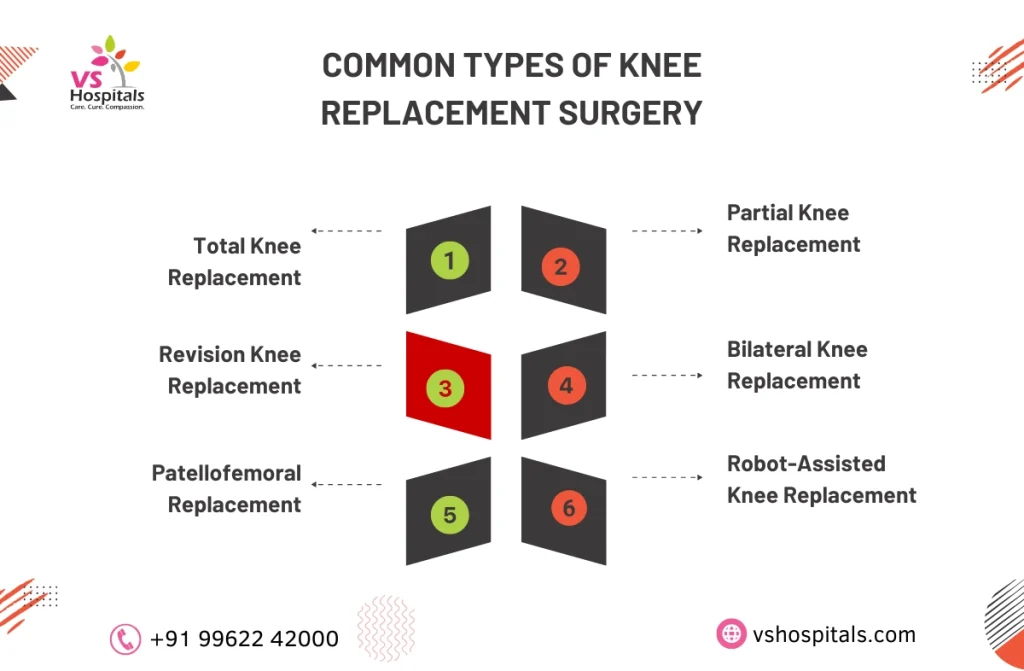Knee replacement surgery can greatly improve the quality of life for individuals suffering from knee pain and mobility issues. Understanding the different types of knee replacement surgery is essential for making an informed decision about your treatment. At VS Hospital, we specialize in a variety of knee surgeries to address various conditions and levels of joint damage. In this blog post, we will explore the different knee surgeries available, helping you to understand the best type of total knee replacement suited for your needs. Whether it’s a total knee replacement, partial knee replacement, or more advanced techniques like robot-assisted surgery, we will cover the essentials to help you choose the right option for your situation.
What is Knee Replacement Surgery?
Knee replacement surgery is a medical procedure where a damaged or diseased knee joint is replaced with an artificial implant. This surgery is often recommended for individuals with severe knee arthritis, injuries, or chronic pain that does not improve with other treatments. The best type of total knee replacement is designed to restore function, alleviate pain, and improve the overall quality of life.
During the procedure, the surgeon removes the damaged cartilage and bone and replaces them with artificial components made from metal and plastic. This helps to reduce pain and improve mobility, allowing patients to return to their daily activities more comfortably. Understanding the various types of knee replacement surgery will guide you in choosing the right option based on your specific needs.

Common Types of Knee Replacement Surgery
There are several types of knee replacement surgery available, each tailored to address specific conditions and patient needs. The most common procedures include:
- Total Knee Replacement: Involves replacing the entire knee joint.
- Partial Knee Replacement: Replaces only the damaged part of the knee.
- Revision Knee Replacement: Addresses issues from a previous knee replacement.
- Bilateral Knee Replacement: Replaces both knees in one surgery.
- Patellofemoral Replacement: Focuses on the kneecap area.
- Robot-Assisted Knee Replacement: Utilizes robotic technology for precision.
Understanding these joint replacement surgery types helps patients identify the best type of total knee replacement suited for their unique situation.
Total Knee Replacement
Total knee replacement is the most common procedure among different knee surgeries, designed for patients with widespread knee joint damage. This surgery involves replacing the entire knee joint with an artificial implant. The best type of total knee replacement uses advanced materials and techniques to ensure a durable and effective solution for patients. During this procedure, the surgeon removes the damaged cartilage and bone from the knee joint and replaces it with a prosthetic joint. This can significantly relieve pain and restore function, allowing patients to return to their normal activities.
Procedure
- Pre-operative assessment and imaging
- Administration of anesthesia
- Removal of damaged joint surfaces
- Placement of the new prosthetic joint
- Closure of the incision and recovery monitoring
Risks
- Infection
- Blood clots
- Implant failure
- Nerve damage
Benefits
- Pain relief
- Improved mobility
- Enhanced quality of life
- Long-lasting results
Partial Knee Replacement
Partial knee replacement is suitable for patients with localized damage in one part of the knee joint. This surgery focuses on replacing only the damaged area while preserving the healthy tissue. It’s a less invasive option compared to total knee replacement and is part of the types of knee replacement surgery. Patients often experience quicker recovery times and less post-operative pain.
Procedure
- Pre-operative assessment and imaging
- Administration of anesthesia
- Removal of the damaged section of the knee
- Placement of the partial prosthetic joint
- Closure of the incision and recovery monitoring
Risks
- Infection
- Blood clots
- Persistent pain
- Need for further surgery
Benefits
- Quicker recovery
- Less pain post-surgery
- Preserved healthy knee tissue
- Improved mobility
Revision Knee Replacement
Revision knee replacement is performed when a previous knee replacement surgery has failed or when there are complications. This surgery involves removing the existing implant and replacing it with a new one. It falls under the types of knee replacement surgery for patients who need additional intervention due to issues such as implant loosening or infection.
Procedure
- Pre-operative assessment and imaging
- Administration of anesthesia
- Removal of the old implant
- Placement of a new prosthetic joint
- Closure of the incision and recovery monitoring
Risks
- Infection
- Increased recovery time
- Implant complications
- Damage to surrounding tissues
Benefits
- Relief from pain
- Improved knee function
- Correction of previous surgery issues
- Better long-term outcomes
Bilateral Knee Replacement
Bilateral knee replacement involves replacing both knees in a single surgical procedure. This approach is beneficial for patients suffering from severe arthritis or knee pain in both joints. It is considered one of the types of knee replacement surgery, offering patients the advantage of undergoing one surgery instead of two separate ones.
Procedure
- Pre-operative assessment and imaging
- Administration of anesthesia
- Simultaneous replacement of both knee joints
- Closure of the incisions and recovery monitoring
Risks
- Longer surgery time
- Higher risk of complications
- Increased pain and recovery time
- Blood clots
Benefits
- Simultaneous recovery for both knees
- Reduced overall hospital visits
- Faster return to daily activities
- Potentially lower overall surgical risks
Patellofemoral Replacement
Patellofemoral replacement is a specialized procedure targeting the kneecap and the groove where it moves. This surgery is suitable for patients with arthritis localized to the patellofemoral compartment. It falls under the types of knee replacement surgery and aims to preserve healthy tissues in the other parts of the knee.
Procedure
- Pre-operative assessment and imaging
- Administration of anesthesia
- Removal of the damaged patellar surface
- Placement of the patellofemoral implant
- Closure of the incision and recovery monitoring
Risks
- Infection
- Knee instability
- Recurrent pain
- Need for further surgery
Benefits
- Less invasive than total knee replacement
- Preserves healthy tissue
- Reduced recovery time
- Improved function of the kneecap
Robot-Assisted Knee Replacement
Robot-assisted knee replacement uses advanced technology to improve the precision of the surgery. This method can be applied to total and partial knee replacements, making it a modern option within the types of knee replacement surgery. The robotic system allows for personalized surgery based on the patient’s anatomy, enhancing the overall results.
Procedure
- Pre-operative assessment and imaging
- Administration of anesthesia
- Use of robotic system for precision in surgery
- Placement of the prosthetic joint
- Closure of the incision and recovery monitoring
Risks
- Surgical complications
- Equipment malfunction
- Higher costs
- Learning curve for the surgeon
Benefits
- Enhanced precision and accuracy
- Potentially shorter recovery times
- Tailored surgical approach
- Better alignment and function of the knee joint
Conclusion
Understanding the types of knee replacement surgery is essential for anyone facing knee issues. At VS Hospital, we offer various options tailored to meet the individual needs of our patients. From total and partial knee replacements to the innovative robot-assisted surgeries, we ensure that every patient receives the best possible care. Whether you are considering different knee surgeries or are already preparing for joint replacement surgery types, our experienced team is here to help guide you through every step of the process, ensuring a smooth journey towards recovery.
Read also Cancer and mental health
